Your donation will support the student journalists of Las Vegas Academy of the Arts. Your contribution will allow us retain our independence as journalists and to purchase equipment, attend journalism conferences, and cover our annual website hosting costs.
Post War Jazz and the Birth of Bebop
April 3, 2023

By the early 1940s, Jazz had cemented its place in American culture, with big bands at the height of their popularity. However, with the outbreak of World War II, jazz began to face new troubles, forcing a shift in the music and culture associated with it. Wartime taxes, the draft, and the military’s need for certain resources (like shellac, used in creating records) all hurt the music industry, especially big bands. From 1940-1942, conflicts between unions and musician associations ( American Federation of Musicians, American Society for Composers, Authors, and Publishers, etc.) and broadcasters/record companies led to a shift in record signings and airplay. Specifically, big bands gave way to pop singers, and west coast music began to rise in popularity above the east coast. The mid-1940s recording ban also led to the creation of many independent jazz labels, which generally allowed the artists they signed the freedom to record whatever material they chose.
The fall of big bands left even more room for the already growing trend of small combo jazz. Built from jam sessions and jazz clubs (specifically jams with the Earl Hines Orchestra at Milton’s Playhouse in Harlem), musicians like Charlie Parker, Dizzy Gillespie, Thelonious Monk, Coleman Hawkins, and Max Roach spearheaded this new movement that would become known as bebop. Because this style was based on jam sessions and collaborations between young innovators, bebop was built on advancements in jazz harmony, melodic development, and improvisation. (On a side note, the focus on advanced harmony inspired many musicians to draw from Broadway show tunes from the 1930s, as opposed to Tin Pan Alley tunes, which were previously popular as bases for jazz music. This would lead to the idea of the Great American Songbook.) Bebop tended to favor uptempo, intricate melodies, with complex improvisation over a jam session format: head (melody), solos, head. These attributes appealed to many young musicians, but were less popular in the mainstream, leading to a huge development in jazz history, the shift from popular music to intellectual, “musician’s” music. This can also be seen as a shift from entertainment to art. The style focused more on virtuosity and improvisation than arrangement and expanded the role of the rhythm section. Soloists were still the focus, but with bebop, the rhythm section gained a much more important role in interacting with and supporting the soloist. Bebop also cemented what is now the traditional, default jazz band setup: drums, upright bass, piano, and 1-3 horns (specifically saxophones and trumpets). Jazz harmony was also expanded, adding complexity that allowed more diverse and interesting melodies and solos.
Bebop took the jazz world by storm, taking jazz out of the mainstream, even for musicians that continued to play swing and more popular styles. It would also force jazz through further evolutions, including styles like hard bop, modal jazz, cool jazz, and later styles like jazz fusion. The birth of bebop is essentially synonymous with the birth of jazz as we know it today.
Sources
Herbie Hancock Institute of Jazz. (n.d.). Jazz in America: Timeline. Jazz in America. Retrieved February 18, 2023, from https://www.jazzinamerica.org/JazzResources/Timeline/1920/1929
Jazz History: The Standards (1940s). (n.d.). Jazz Standards. Retrieved March 3, 2023, from https://www.jazzstandards.com/history/history-4.htm.
MasterClass. (n.d.). What Is Bebop? A Guide to the History and Sound of Bebop – 2023. MasterClass. Retrieved March 3, 2023, from https://www.masterclass.com/articles/bebop-guide.
NPR. (2008 January 23). Jazz in Song: The Standard. NPR. Retrieved March 3, 2023, from https://www.npr.org/2008/01/23/18302782/jazz-in-song-the-standard.
Tin Pan Alley. (n.d.). American Music: Tin Pan Alley American Popular Music Project. Retrieved March 3, 2023, from https://www.tinpanalley.nyc/.